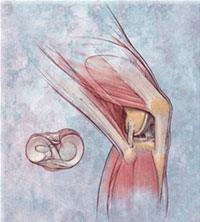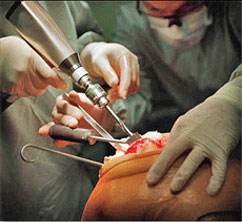Location
202, Sanskruti Shilp, 62/4 Tarate Colony,
Jagannath Tarate road, Pune 4
(+91)77570 21455
Call For Appointments
E-mail us hwakankar@gmail.com
Structure of knee joint
 The knee is the largest weight-bearing joint in the body. Nearly normal knee function is needed to perform routine everyday activities. The knee is made up of the lower end of the thigh bone (femur), which moves on the upper end of the shin bone (tibia), and the knee cap (patella), which slides in a groove on the end of the femur. Large ligaments attach to the femur and tibia to provide stability. The long thigh muscles give the knee strength for movement.
The knee is the largest weight-bearing joint in the body. Nearly normal knee function is needed to perform routine everyday activities. The knee is made up of the lower end of the thigh bone (femur), which moves on the upper end of the shin bone (tibia), and the knee cap (patella), which slides in a groove on the end of the femur. Large ligaments attach to the femur and tibia to provide stability. The long thigh muscles give the knee strength for movement.
The joint surfaces where these three bones move against each other are covered with articular cartilage, a smooth tissue that cushions the bones and enables them to move easily. All remaining surfaces of the knee are covered by a thin, smooth tissue liner called the synovial membrane. In a healthy knee, this membrane releases a special fluid that lubricates the knee and almost eliminates the friction.
Freedom from PAIN of arthritic knee joint is now possible with Total Knee Replacement operation. If your knee has been damaged by arthritis or injury, simple activities such as walking or getting in and out of surfaces, knee replacement surgery can relieve your pain and help you get back to enjoying normal, everyday activities.
Total Knee Replacement is a virtual medical miracle for those patients crippled with arthritis of the knee. It was first performed in 1968. Improvements in joint replacement surgical techniques and technology have greatly increased the effectiveness of this surgery. Today, more than 245,000 knee replacements are performed each year in the United States of America.
The knee is the largest weight-bearing joint in the body. Nearly normal knee function is needed to perform routine everyday activities. The knee is made up of the lower end of the thigh bone (femur), which moves on the upper end of the shin bone (tibia), and the knee cap (patella), which slides in a groove on the end of the femur. Large ligaments attach to the femur and tibia to provide stability. The long thigh muscles give the knee strength for movement.
The joint surfaces where these three bones move against each other are covered with articular cartilage, a smooth tissue that cushions the bones and enables them to move easily. All remaining surfaces of the knee are covered by a thin, smooth tissue liner called the synovial membrane. In a healthy knee, this membrane releases a special fluid that lubricates the knee and almost eliminates the friction.
Normally, all of these components work in harmony. But disease or injury can disrupt this harmony, resulting in pain, muscle weakness, and less function.
Common Causes of Knee Pain and Loss of Mobility
 The most common cause of chronic knee pain and disability is Arthritis. Osteoarthritis, rheumatoid arthritis, and traumatic arthritis are the most common forms of this disease.
The most common cause of chronic knee pain and disability is Arthritis. Osteoarthritis, rheumatoid arthritis, and traumatic arthritis are the most common forms of this disease.
Osteoarthritis usually occurs after age 50. The articular cartilage covering & cushioning the bones of the knee softens & wears away. The bones then rub against each other, causing knee pain and stiffness.
Rheumatoid Arthritis is a disease in which the synovial membrane becomes thickened & inflamed, produces too much synovial fluid. This cronic inflammation damages the cartilage, leading to pain and stiffness.
Traumatic Arthritis can follow a serious knee injury like fracture or ligament tear. This damages the cartilage leading to arthritis.
Do I need Knee Replacement Operation?
 The decision whether to have knee replacement surgery should be a cooperative one between you, your family, & your orthopaedic surgeon. While most patients who undergo knee replacement surgery are of age 60 to 80, age is not the only criteria.
The decision whether to have knee replacement surgery should be a cooperative one between you, your family, & your orthopaedic surgeon. While most patients who undergo knee replacement surgery are of age 60 to 80, age is not the only criteria.
Orthopaedic surgeons evaluate patients individually & recommendations for surgery are based on the extent of your pain, disability, and general health status, not solely on age.
You may benefit from knee replacement surgery if you have:
- Severe knee pain that limits your everyday activities, including walking, going up and down stairs, and getting in and out of chairs. You may find it hard to walk more than a few hundred feet without significant pain and you may need to use a cane or walker.
- Moderate or severe knee pain while resting, either day or night.
- Chronic knee inflammation and swelling that doesn’t improve with rest or medications.
- Knee deformity—a bowing in or out of your knee.
- Knee stiffness—inability to bend and straighten your knee.
- Limited pain relief from anti-inflammatory medicines. These medications, including ibuprofen, diclofenac & nimesulide often are most effective in the early stages of arthritis. Their effectiveness in controlling knee pain varies greatly from person to person. These drugs become less effective for patients with severe arthritis.
- Inability to tolerate or complications from pain medications.
- Failure to substantially improve with other treatments such as cortisone injections, physiotherapy, or other surgeries.